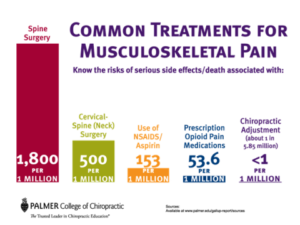Below is a statement from Palmer College of Chiropractic that has been doing studies on the relationship between chiropractic and stroke. They also have been working with other organizations, such as Penn State Medical Center who also have been doing studies to determine if there is a risk related. The bottom line, NO there is not a risk or correlation between chiropractic adjustments and stroke. In fact you are 153 times more likely to die from taking ibuprofen!!
About every five years this topic comes back up, which is why the chiropractic community has done so much research on the actual facts.
10/21/16
Statement from Palmer College of Chiropractic regarding stroke risk
Someone in America dies from stroke every four minutes. While many people are familiar with the signs and symptoms of the most common forms of stroke, which tend to disproportionately affect older adults, there has been less public outreach regarding Cervical Artery Dissection (CAD), which can lead to a rare form of stroke that affects adults aged 45 or younger. The vast majority of CAD cases are spontaneous, meaning that the underlying cause is unknown.
Because there are documented cases in which a patient has sought chiropractic care prior to experiencing CAD, some medical physicians have hypothesized that spinal manipulative therapy may result in CAD and stroke. However, neither the clinical or basic-science research available on this issue has established a cause-and-effect relationship. (See the video from the Palmer Center for Chiropractic Research for more information.)
The two most rigorous clinical studies published to date (Cassidy et al, Spine 2008; Elton et al, Chiropractic and Manual Therapies, 2015) found that patients were as likely to have gone to a medical doctor as a doctor of chiropractic before the stroke occurred. The authors of both studies concluded that any increased risk of CAD-induced stroke associated with chiropractic and primary care physician visits is most likely caused by patients seeking care for CAD symptoms, such as headache and neck pain, before their stroke occurs.
Authors of a subsequent review of the literature from the Department of Neurosurgery at the Penn State Hershey Medical Center (Church et al, Cureus 2016), concluded, “There is no convincing evidence to support a causal link between chiropractic manipulation and CAD. Belief in a causal link may have significant negative consequences …”
Findings from these clinical studies are supported by basic-science research, which shows that the biomechanical impact of cervical manipulation doesn’t cause strains to the internal carotid artery or vertebral artery blood flow in excess of those experienced during normal, everyday movements (Herzog et al, JMPT, 2012; Quesnele et al, JMPT, 2014).
Research shows chiropractic is a safe and effective treatment for musculoskeletal conditions, including neck pain and headaches (http://nbce.wpengine.com/wp-content/uploads/chapter_02.pdf), when compared to other treatments available. The following chart provides information regarding some of these treatments.
It’s important that all health-care providers, including doctors of chiropractic, be aware of the signs and symptoms associated with CAD so they can make appropriate referrals when necessary. It’s equally important that patients are given accurate, evidence-based facts about the risks and benefits of all available treatments so they’re able to make an informed decision.

